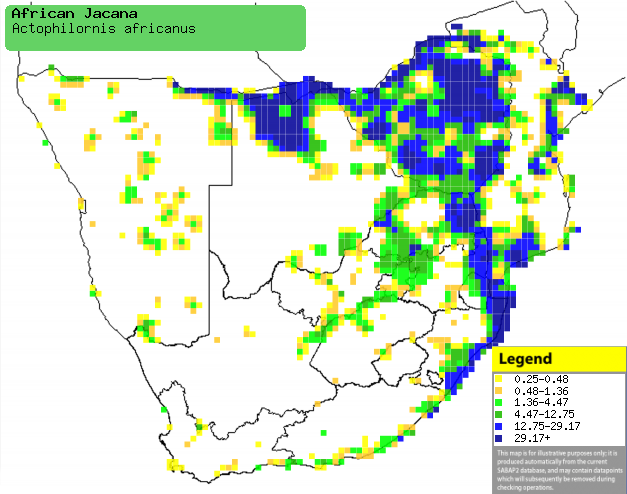|
Actophilornis africanus (African
jacana)
Grootlangtoon [Afrikaans]; iThandaluzibo, uNondwayiza
[Zulu]; Nkongoro [Kwangali]; Lelie-loper [Dutch]; Jacana à poitrine dorée
[French]; Blaustirn-blatthühnchen, Jacana [German]; Jacana-africana
[Portuguese]
Life
> Eukaryotes >
Opisthokonta
> Metazoa (animals) >
Bilateria >
Deuterostomia > Chordata >
Craniata > Vertebrata (vertebrates) > Gnathostomata (jawed
vertebrates) > Teleostomi (teleost fish) > Osteichthyes (bony fish) > Class:
Sarcopterygii (lobe-finned
fish) > Stegocephalia (terrestrial
vertebrates) > Tetrapoda
(four-legged vertebrates) > Reptiliomorpha > Amniota >
Reptilia (reptiles) >
Romeriida > Diapsida > Archosauromorpha > Archosauria >
Dinosauria
(dinosaurs) > Saurischia > Theropoda (bipedal predatory dinosaurs) >
Coelurosauria > Maniraptora > Aves
(birds) >
Order: Charadriiformes > Family: Jacanidae
Distribution and habitat
Occurs across sub-Saharan Africa; in southern Africa it is locally abundant in northern
Botswana, the Caprivi Strip, Zimbabwe, Mozambique and eastern South Africa,
while more scarce elsewhere in Namibia and South Africa. It generally prefers
shallow, freshwater wetlands and margins of slow-flowing rivers with low
vegetation, especially areas dominated by water-lilies (Nymphaea),
Willowherb (Ludwigia stolonifera), pondweeds (Potomogeton) and
hornwarts (Ceratophyllium).
|
 |
|
Distribution of African jacana in southern Africa,
based on statistical smoothing of the records from first SA Bird Atlas
Project (©
Animal Demography unit, University of
Cape Town; smoothing by Birgit Erni and Francesca Little). Colours range
from dark blue (most common) through to yellow (least common).
See here for the latest distribution
from the SABAP2. |
Movements and migrations
Highly nomadic, often moving in search of new
temporary wetlands.
Predators and parasites
- Predators of chicks and eggs
Food
It mainly eats insects, doing most of its foraging on
floating vegetation, walking or running with its large feet while plucking prey from plants
and the water surface. The following food items have been recorded
in its diet:
- Invertebrates
- insects
- crustaceans
- molluscs
-
spiders
- Vertebrates
Breeding
- Sequentially polyandrous, meaning that one female mates with multiple
males over the course of one breeding season. It is highly territorial, as
males fight each other for control of prime breeding territory, displaying
and calling from a calling post made by pulling a few plant stems together.
- The nest (see images below) is a flimsy, damp heap of aquatic plant
stems, in fact the eggs are often just 2 cm above the water surface. It is
typically placed out in the open or concealed by vegetation, especially Willowherb (Ludwigia stolinifera). Due to their close proximity to
the water surface the brood are vulnerable to changing water levels, which can
cause the breeding pair to hastily assemble a new platform to move the young
or eggs to.
- Egg-laying season is year-round, peaking from November-March.
- It lays 3-5, usually 4 eggs, which are incubated solely by the male for
about 23-27 days.
- The chicks are cared for by the male only, leaving the nest within
four hours of hatching. They are often carried under the males for up to 18
days, in fact when they are small the male can fit up to four chicks
under its wings. They take their first flight at about 39-44 days old,
becoming independent at 40-50 days old.
Threats
Not threatened, as its distribution has remained largely unchanged
for the past century.
References
-
Hockey PAR, Dean WRJ and Ryan PG 2005. Roberts
- Birds of southern Africa, VIIth ed. The Trustees of the John Voelcker
Bird Book Fund, Cape Town.
|
